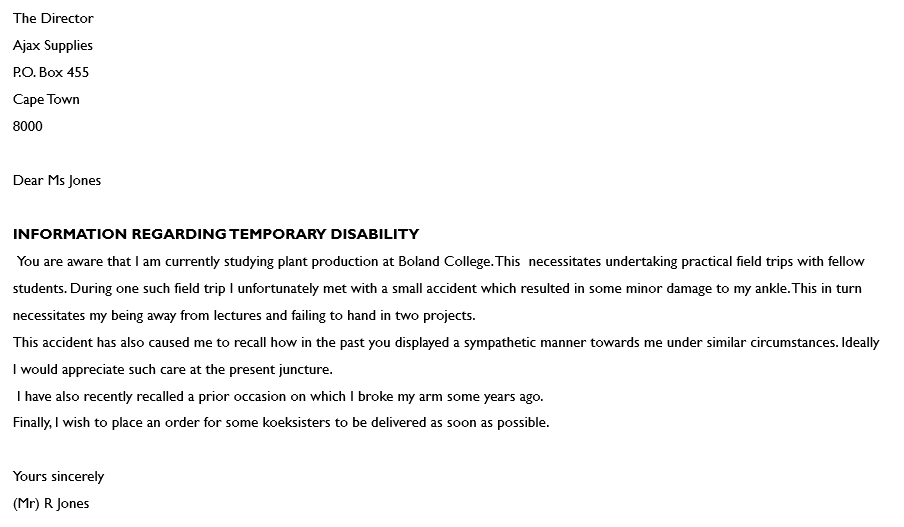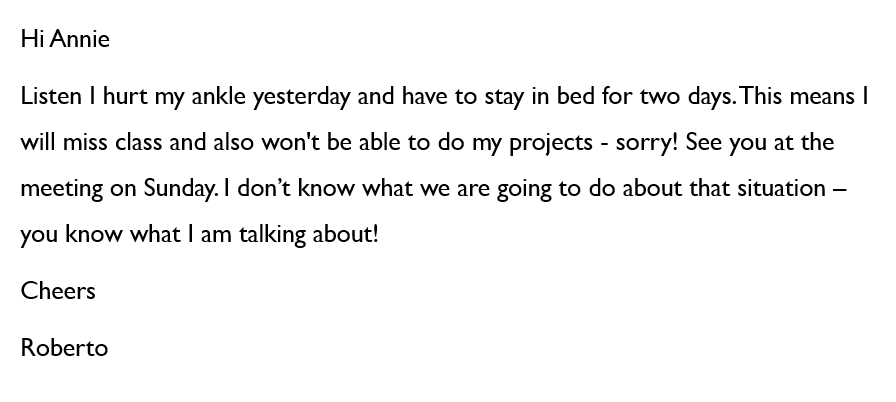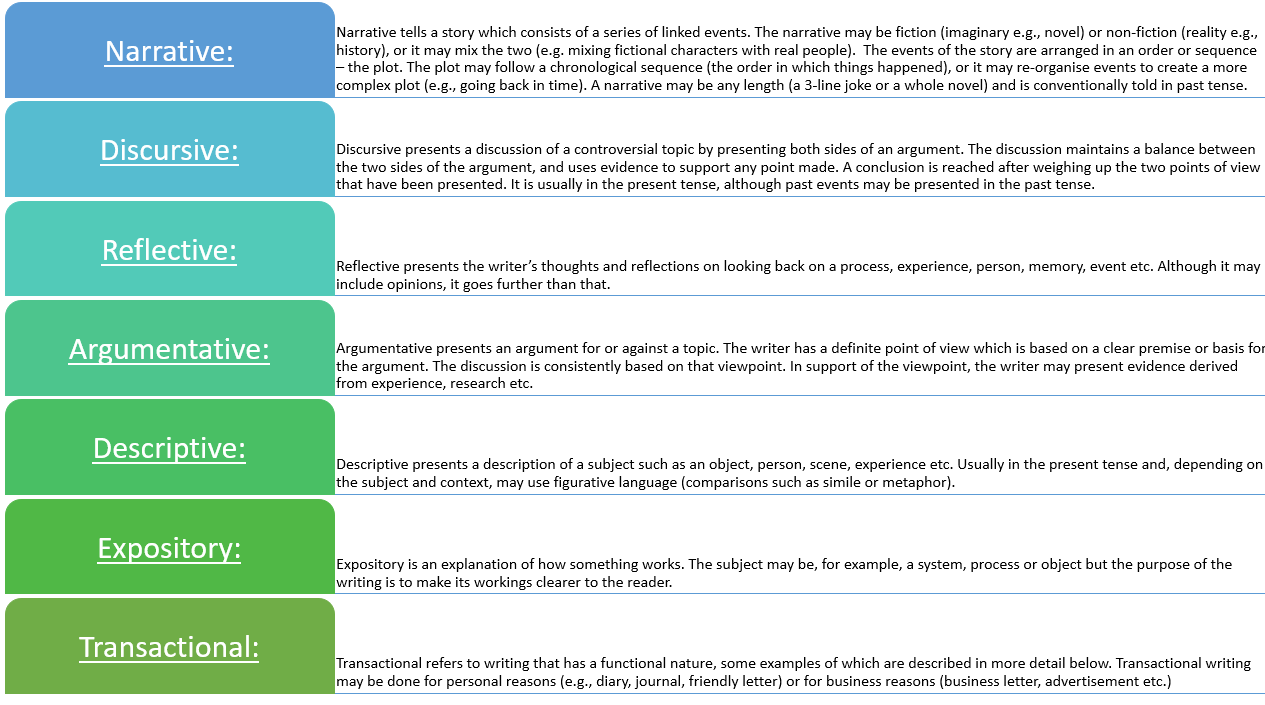In this section, we will look carefully at why we need to write something, what that piece of writing will say and how it will say it in the best manner. In the process, we will work with examples of the basic types of written text, and improve our skills of gathering and organizing information to produce an effective piece of writing.
Purpose, Audience and Context
Many people feel intimidated by having to produce a piece of writing, and you may be one of them. We may feel quite comfortable speaking to people, but when we have to write, it feels quite different. It’s just that we are more used to speaking than to writing. Yet, there are occasions in our lives when we have to produce something in written format. We may even want to write.
So, the first thing to keep in mind is that writing is essentially speech that has been written down. And just as when you speak, there is a context - you are saying something to someone - so when you write, you are writing to a reader, or an audience and you are writing for a purpose. The advantage is writing is a process that gives you the chance to ‘get it right – you can think about why you are writing, what you are going to write and how best to say it. You can make thoughtful choices, try things out, correct or change what you have written and finally produce the best piece of writing that you can. This Section will start you on the process of becoming an effective writer.
We will use the word text to refer to any piece of writing that is presented for consideration. This includes writing of any length(from a single letter or word to a book).
More generally, the term text may be used to refer to any product that can be read, decoded (understanding of any other kind of text e.g., picture) or deconstructed (analysed to understand how it works). Thus, although we will be working mainly with written texts, other examples of ‘text’ are oral (spoken) text, a movie, a painting, a chocolate wrapper.
Selection of Appropriate Text

Consider the two write-ups below.

Both are written by the same person, in response to the same set of events, but what is different about these two pieces of writing?
Your writing needs to suit your audience.
- Hence they are differences in style: The mail is informal, chatty and colloquial (using everyday language). The letter on the other hand is formal, serious and distant.
- There are differences in the form: the email has no address and is not as carefully punctuated. The letter has an address, is well punctuated and ends with a formal salutation (greeting).
Now let us account for why these pieces of writing are so different.
Consider the context, audience and purpose of each text, and think about how these factors affect what is written and how it is expressed.
The context for the example of the email is a son writing to his mother. He is informing her that he had an accident. He is also writing from the point of view of a son missing the care he would get at home. The letter, however, is written in the context of a student asking for exemption from lectures and due dates.
Remember, when you produce a piece of writing, your reader may be picking up a range of cues regarding the context in which you are writing that piece. You should therefore, be aware of the implications (intentional or otherwise) of what you write.
What about the audience and purpose? How do they affect what is written and how it is written?
The audience for the first piece – the email – is his mother, clearly someone he knows intimately. So what he writes about is detail of his accident and how he is feeling, as well as his nostalgia for home. By analysing his writing, we can detect an informality that reminds us of spoken language. Roberto's email resembles a chat with his mum.
What is his purpose? His purpose is to inform his mother of what has happened to him. Partly it is also to ask for sympathy and to make a request for a gift.
The audience of the second text is a lecturer. This person is able to excuse Roberto from lectures and give him an extension of his due date for one of his projects. Thus, we can see how the writer chooses a form of writing that is suited to the context, audience and purpose of the text.
Selection of Appropriate Language
Using appropriate language is a critical factor in writing. You have done work on issues such as sexism, racism and ageism. You are aware that using language that is insensitive to these and other socio-cultural issues is inappropriate.
Similarly, using a particular form of writing or type of text is critical to the message being conveyed. Choosing an inappropriate form for a piece of writing may have an effect that is entirely unintended.
What happens if an inappropriate text type, style and register are used? We can gauge the effects of this if we try writing each of Roberto's texts in a different form. Let us see how each example might work (or not work!).
MAIL A in a Business Context
First, consider the piece written by Roberto to his mother. It happens that his mother used to be the owner of a small business.
Consider how appropriate it would be for Roberto to write her a business letter in the form of an email:

As a business letter, it has a perfectly correct form. But is it appropriate in this context?
Roberto's email to his mother is inappropriate in the following ways:-
- The form of greeting is formal (although as an email it does not put in details of address). The content leaves out details that would be relevant to a mother.
- The style: uses an over-formal register, vocabulary (present juncture, necessitates), syntax (You are aware…, finally I wish, this in turn…)
- Clearly, this letter is totally inappropriate to the context, the audience (his mother as mother, not his mother as businesswoman) and the purpose (to share his feelings and make a very personal request, not to make a business proposal).
LETTER B in an informal context:
But let us consider Roberto's letter to the lecturer.
Let us suppose that the context was not as simple as we first assumed. What would happen if the relationship between Roberto and the lecturer had another side to it? Let us suppose that Roberto and the lecturer are members of the same church and know each other quite well as they have served on the church youth group committee together for two years. How could that affect the way Roberto writes his letter?
Imagine that Roberto had sent the following letter to his lecturer, which he knows well from church:

Do you think this letter is appropriate?
Before you answer, imagine that you are the lecturer and that in your department all
requests for extensions get sorted by the administrative assistant to send to the academic
committee. They are therefore read by three different staff members.
Here are some in terms of appropriateness:
Format: Too casual, no address given.
Style: Too informal, personal and intimate.
Register: Inappropriate - too familiar and too indiscreet.
In the above example, Roberto may know the lecturer personally, but he is still writing to her as the lecturer. It would therefore be inappropriate for him, in this situation, to make any reference to their church connection, or to adjust his approach to writing an official letter.
Remember that, in official communication, personal relationships are not relevant and reference to them would be insensitive to the reader. Making the wrong choices could undermine the integrity of both the writer and the reader.
In the examples we have just worked through, we looked at how the same events can be written about in two very different ways. In each case a different type of text was used. The choice for using the particular type of text depended on the audience being written for, and the purpose of the writing. We made sure that the language being used was appropriate to the sensitivities of the recipient. We then considered the consequences of choosing the wrong form and inappropriate language.
Selection of Appropriate Genre
Let us now give some attention to types of text. We have so far looked at a friendly email, a formal letter, a friendly letter and a business letter. We will now expand our scope to include not only letters, but many more types of text, or genres, which can be used for writing.
Genre: A genre is a form or category of written text.

Different formats will apply for different purposes:
Advertisements can be in the form of fliers, brochures, magazine adverts, television adverts etc.
Electronic texts e.g., email, SMSs
Multi-media presentations e.g., power-point, video
Business letters have a specific format and conventions.
Click here to download a handout that indicates the format of a business letter.